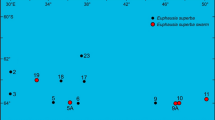Abstract
This paper studies morphometric parameters (body weight, weight of internal organs, body size, etc.) in 170 elk of various sex and age obtained in the Vyatka taiga area in winter. A number of physiological parameters (specific metabolism and thermal conductivity, heat loss rate, etc.) characterizing the metabolic rate and energy balance in the body were calculated for model animals (calf, male, and female). It is noted that in the transition from the first to the second half of winter the specific metabolism in model animals decreased from 20.6, 16.9, and 15.9 to 18.7, 15.4, and 14.5 kcal/(kg day), respectively. It is shown that changes in the rhythm of motor activity of elk are synchronized with the daily air temperature and the maximum flight distance depends on the amount of energy received by the body with food.
Similar content being viewed by others
References
Van Beest, F.M. and Milner, J.M., Behavioural responses to thermal conditions affect seasonal mass change in a heat sensitive northern ungulate, PLoS One, 2013, vol. 8, no. 6, pp. 1–13 (access freely available online).
Bradley, S.R. and Deavers, D.R., A reexamination of the relationship between thermal conductance and body weight in mammals, Comp. Biochem. Physiol., 1980, vol. 63A, pp. 465–476.
Brosh, A., Heart rate measurements as an index of energy expenditure and energy balance in ruminants: a review, Anim. Sci., 2007, vol. 85, pp. 1213–1227.
Chermnykh, N.A., Moose physiology, in Biologiya iispol’zovanie losya (Biology and Use of the Moose), Moscow: Nauka, 1986, pp. 55–60.
Cohen, Y., Robbins, C.T., and Davitt, B.B., Oxygen utilization by elk calves during horizontal and vertical locomotion compared to other species, Comp. Biochem. Physiol., 1978, vol. 61A, pp. 43–48.
Glushkov, V.M., The issue of the diurnal rhythm of the moose in winter, in Okhota–Pushnina–dich’ (Hunting–Furs–Game Animals), Kirov: NTI VNIIOZ, 1974, no. 46, pp. 35–41.
Glushkov, V.M., Hunting as a factor of energy deficiency in the moose, Vestn. Okhotovedeniya, 2004, vol. 1, no. 1, pp. 18–35.
Hjeliord, O., Saether, B.E., and Andersen, R., Estimating energy intake of freeranging moose cows and calves through collection of feces, Can. J. Zool., 1994, vol. 2, no. 8, pp. 1409–1415.
Knorre, E.P., Moose ecology, Tr. PechoroIlychsk. Gos. Zapov., 1959, no. 7, pp. 5–122.
Knorre, E.P. and Knorre, E.K., Patterns of growth and sea sonal changes in the body weight of the moose, Zool. Zh., 1956, vol. 35, no. 8, pp. 1229–1237.
Knorre, E.P. and Knorre, E.K., Materials for the study of some physiological characteristics of the moose, Tr. PechoroIlychsk. Gos. Zapov., 1959, no. 7, pp. 133–167.
Kochanov, N.E., Ivanova, G.M., Veber, A.E., and Simakov, A.F., Obmen veshchestv u dikikh zhvachnykh zhivotnykh (severnye oleni i losi) (Metabolism in Wild Ruminants (Moose and Reindeer)), Leningrad: Nauka, 1981.
Kuznetsov, G.V., The role of moose in the energy transfer in forest biogeocenoses, in Pochvy i produktivnost’ rastitel’nykh soobshchestv (Soils and Productivity of Plant Communi ties), Moscow: Izd. MGU, 1976, vol. 3, pp. 140–147.
Lenarz, M.S., Nelson, M.E., Schrage, M.W., and Edwards, A.J., Temperature mediated moose survival in northeastern Minnesota, J. Wildlife Management, 2009, vol. 73, no. 4, pp. 503–510.
Moen, R., Pastor, J., and Cohen, Y., Interpreting behavior from activity counters in GPS collars on moose, J. ALCES, 1996, vol. 32, pp. 101–108.
Nasimovich, A.A., The experience of studying the ecology of mammals by winter tracking, Zool. Zh., 1948, vol. 27, no. 4, pp. 371–372.
Renecker, L. and Hudson, R., Seasonal energy expenditures and thermoregulatory responses of moose, Can. J. Zool., 1986, vol. 64, no. 2, pp. 322–327.
Renecker, L. and Hudson, R., Ecological metabolism of moose in aspendominated boreal forests, central Alberta, Can. J. Zool., 1989, vol. 67, no. 8, pp. 1923–1928.
Schmidt Nielsen, K., Animal Physiology: Adaptation and Environment, Cambridge University Press, Cambridge, 1979.
Schmidt Nielsen, K., Scaling: Why Is Animal Size So Important?, Cambridge: Cambridge University Press, 1984.
Shvarts, Ch.S., Physiological and nutritional adaptations of moose to northern conditions, in Tez. dokl. III Mezhdunar. simp. po losyu (Abstr. III Int. Symp. on the Moose), Syk tyvkar, 1990.
Slonim, A.D., Ekologicheskaya fiziologiya zhivotnykh (Ecological Physiology of Animals), Moscow: Vyssh. Shk., 1971.
Timofeeva, E.K., Methods for studying the ecology of moose in winter, in Biologiya i promysel losya (Biology and Hunting of the Moose), Moscow: Rossel’khozizdat, 1967.
Yazan, Yu.P., Biological features and the pathways of economic management of populations of migratory moose in Pechora taiga, Tr. PechoroIlychsk. Gos. Zapov., 1961a, no. 9, pp. 202–216.
Yazan, Yu.P., Effect of temperature on the activity of moose during the autumn and winter migrations, Zool. Zh., 1961b, vol. 40, no. 3, pp. 469–471.
Yazan, Yu.P. and Kozhukhov, M.V., Some features of ther moregulation in moose, Tr. PechoroIlychsk. Gos. Zapov., 1964, no. 11, pp. 67–74.
Yazan, Yu.P., Weight and size of the Vyatka moose, Tr. Kirovsk. S.Kh. Inst., 1970, vol. 22, no. 52, pp. 194–202.
Yazan, Yu.P., Okhotnich’i zveri pechorskoi taigi (Game Animals of the Pechora Taiga), Kirov: Kirovsk. Otd. Volgo Vyatsk. Kn. Izd., 1972.
Yazan, Yu.P. and Glushkov, V.M., The behavior of moose in the snow period, in Okhota–pushnina–dich’ (Hunting–Furs–Game Animals), Kirov: NTI VNIIOZ, 1973, nos. 40–41, pp. 67–72.
Author information
Authors and Affiliations
Corresponding author
Additional information
Original Russian Text © V.M. Glushkov, G.V. Kuznetsov, 2015, published in Izvestiya Akademii Nauk, Seriya Biologicheskaya, 2015, No. 4, pp. 441–448.
Rights and permissions
About this article
Cite this article
Glushkov, V.M., Kuznetsov, G.V. Morphophysiological and behavioral adaptations of elk to wintering. Biol Bull Russ Acad Sci 42, 371–377 (2015). https://doi.org/10.1134/S1062359015040068
Received:
Published:
Issue Date:
DOI: https://doi.org/10.1134/S1062359015040068



